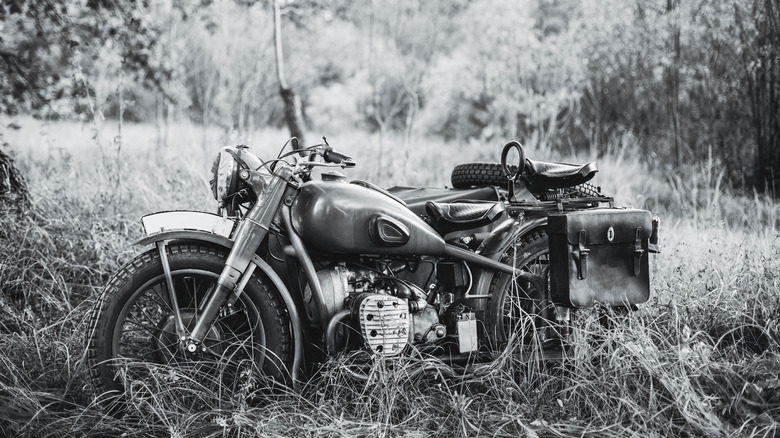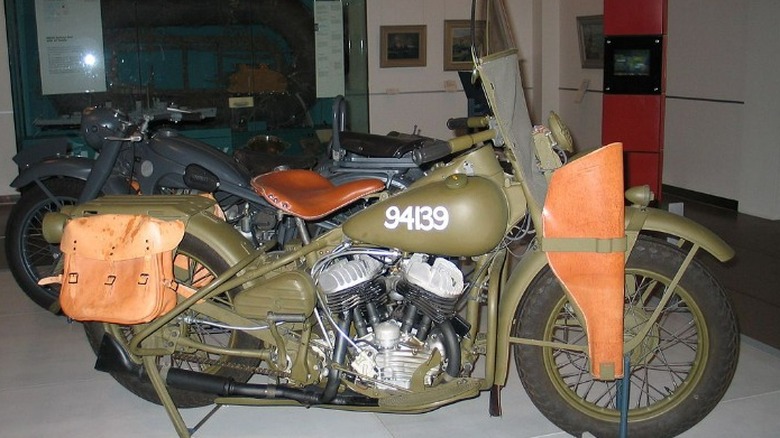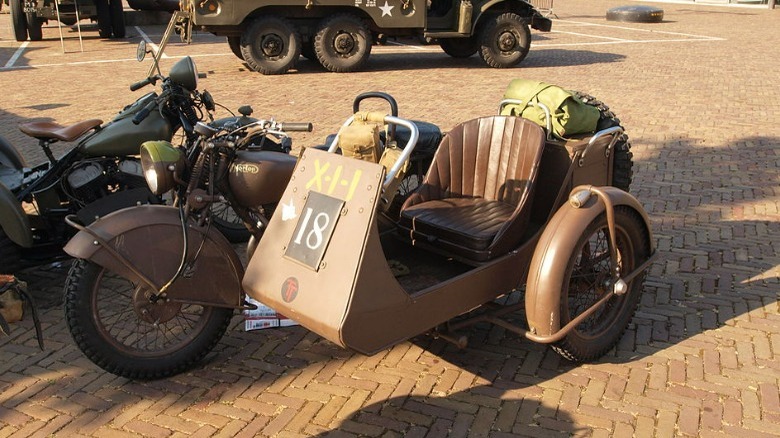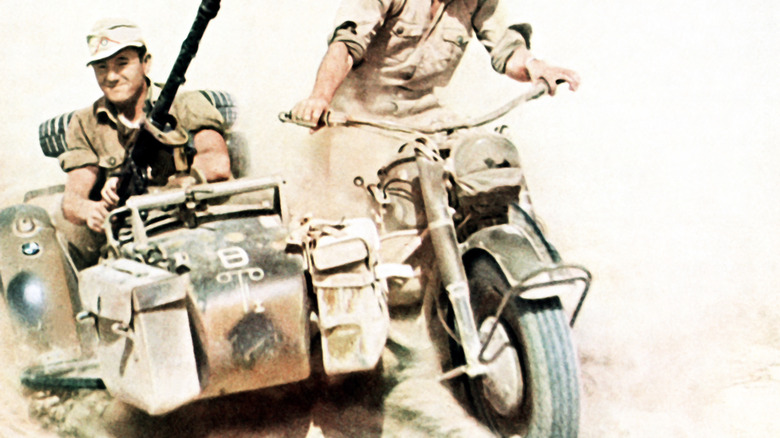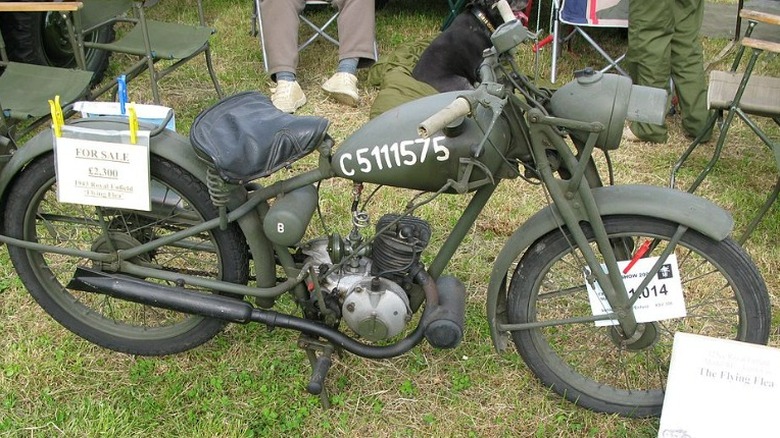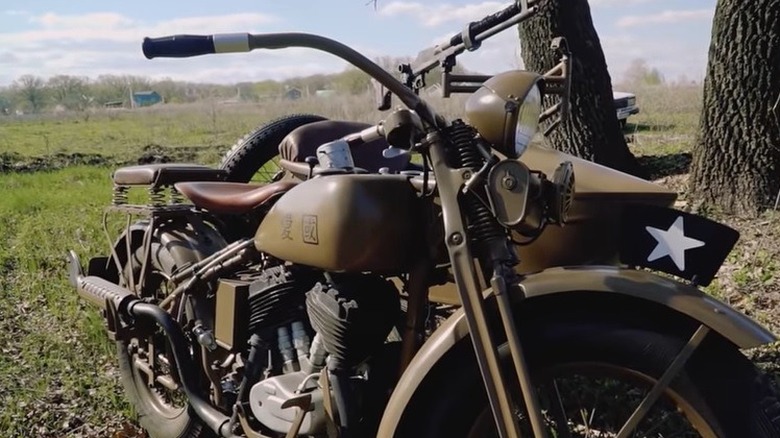The 5 Most Important Motorcycles Of WW2
It might seem odd to think of the motorcycle as a critical piece of military machinery. Yet, motorcycle platforms have been invaluable to military outfits all over the world for decades. In search of Pancho Villa (beginning in 1916), General John Pershing scoured the Mexican countryside with 6,000 troops, horses, airplanes, and of course, motorcycles! This hunt actually illuminates the use case for motorcycles in military outfits perfectly. As engine technology continued to advance, motorcycles took over some of the cavalry duties that horse regiments once held. More importantly, they blossomed into invaluable assets for sending messages and maintaining an essential line of communication between separated units on the battlefield.
In World War II, the use of motorcycles as a reliable means of transporting urgent information really hit its stride. A number of iconic models were introduced to warzones in Europe, Africa, and the Pacific, and they served in a variety of roles. Many were used simply for rapid transportation, but they also served alongside tank units (particularly in the case of German machines), were thrown out of airplanes alongside paratrooper detachments, and featured in other light skirmishing. The motorcycle made its mark on the war, and upon returning home, they were sold in large volumes as surplus equipment to drivers looking to make a statement. Often, veterans took advantage of these inexpensive alternatives to the primary market, launching a cultural wave of ridership long into the future. These five motorcycles were some of the most important of the war and continue to inspire the imagination today.
The Harley-Davidson WLA (USA)
Harley-Davidson is about as American a brand as you'll find. Harleys were a key feature in the U.S. forces' war efforts, and more than 90,000 of them were built to support the Allies during World War II. The WLA model was specific to American forces (with Canadian-destined Harleys being dubbed WLC, for instance). These bikes were also shipped out to the U.K. and Soviet Union through the lend-lease program.
Under American riders, the WLA traversed all theaters of the conflict from Europe and North Africa to the far-flung Pacific islands. WLAs offered a modification to an existing WL platform that Harley-Davidson had built. Adding an ammunition box and scabbard designed so that the rider could quickly draw their rifle or submachine gun, the bike also used saddlebags for additional storage. Many other military models used sidecars to improve storage capacity or additional weaponry options, but the WLA prized maneuverability and quickness, opting to forego this tertiary add-in. The WLA motorcycles used a 45 V2 engine. It was an air-cooled, 4-stroke, 739cc powerplant that partnered with a three-speed gearbox and could reach a top speed of 65 miles per hour. It was an icon during and long after the war.
[Featured image by Bukoved via Wikimedia Commons | Cropped and scaled | CC BY 2.5]
Norton WD Big 4 (U.K.)
Norton has long been a staple in the British motorcycle industry. The Big 4 was initially built in 1907 and saw action in World War I as a tool used by the Russian army. World War II saw a ramp up of production for British soldiers. The WD (War Department) Big 4 could carry as many as three fully outfitted soldiers, and was typically used to carry ammunition and other supplies to frontline forces in need of a resupply. The Big 4's sidecar could also be detached in order to outfit the motorcycle with bombs and other heavy equipment. Big 4 motorcycles could also be outfitted with a 3-inch mortar or a Bren gun for major, mobile stopping power. One thing that sets this bike apart from others on the list is its ruggedness. The Big 4 was purpose-built to run over rough terrain without issue.
Norton built the Big 4 with an 82x120 mm engine that produced power over speed. The engine was a 633cc air-cooled powerhouse built with a single cylinder. Eventually, this workhorse vehicle was replaced by the Willys Jeep and Ford GP in 1941, showcasing its use case as something that departed significantly from the typical light and agile motorcycles used on the battlefield.
[Featured image by AlfvanBeem via Wikimedia Commons | Cropped and scaled | CC0]
BMW R75 (Germany)
While the Allied forces made extensive use of motorcycles in the field, so too did their German adversaries. German-made vehicles are often noted for their craftsmanship and engineering prowess, and the same could be said of their output in the 1930s and '40s. Bayerische Motoren Werke (BMW) began designing the R75 beginning in 1938 and delivered them for military service in 1941. The R75 is prized as one of "the best military motorcycles ever."
The R75 quickly found use alongside Panzer outfits and in the Afrika Corps and Waffen-SS. The bike was powered by a BMW OHV engine measuring 750cc and producing 26 horsepower. The vehicle was driven with the help of a four-speed gearbox. It was versatile and could be used across varying terrains. As such, it was deployed as a messenger tool and for reconnaissance missions -– as with many other motorcycles produced by other nations for the war. The motorcycle was built with a sidecar addition that could be outfitted with a machine gun for light combat duty and ambush prevention as well. BMW produced 16,510 R75s for the German military between 1940 and 1944.
Royal Enfield WD/RE (U.K.)
Another British motorcycle that was routinely used in World War II was anything but the bulky people and equipment carrier that the Big 4 represented. Royal Enfield's WD/RE was a lightfooted motorcycle that looks more like an actual bicycle than a prototypical motorcycle.
The bike's moniker combined WD for War Department with Royal Enfield's initials, RE, which entered into the company's naming conventions of the era. It was often dropped over battlefields by parachute alongside soldiers entering the fight from above. These drops were also dispatched as dedicated messengers, allowing central command infrastructure to put a biker and his steed on an aircraft and quickly move the information to the front, in person. WD/REs are light enough to lift (as evidenced in a Royal Enfield Facebook post from 2016), weighing a spritely 130 pounds. The bike was powered by an air-cooled, two-stroke 126cc engine and was known affectionately as the "Flying Flea." Primary to the WD/REs mission was agility and so the bike was built to be easily repaired. Perhaps surprisingly, considering its basic frame and minimal infrastructure, the bike's top speed maxed out at a respectable 45 miles per hour and a full tank could bring a rider 130 miles down the road!
[Featured image by Geni via Wikimedia Commons | Cropped and scaled | CC BY-SA 4.0]
Rikuo Type 97 (Japan)
Then there is the Type 97, built by the Rikuo Nainen Company. Rikuo's effort was virtually a carbon copy imitation of the Harley-Davidson Road King. The flattery is uncanny, to say the least. Although the similarities between American and Japanese machines might be surprising (instead of the mechanical overlap between Japanese builds and those coming out of other Axis nations), it's actually easy to explain. In 1932 representatives from Sankyo Seiyaku arrived in Milwaukee to purchase production equipment and a license to build VL-series motorcycles powered by 1,200cc engines. They succeeded in acquiring these from none other than Harley-Davidson (founded in Milwaukee), a company struggling financially at the time. The Axis alliance was still a thing of the future. Japan would only codify itself as a German ally in the war effort in September 1940, and cemented its side on December 7, 1941.
Rikuo rolled out their Type 97 with the use of a twin-cylinder, 1,200cc air-cooled engine and added an integrated sidecar that could be outfitted with a machine gun for combat or light defensive duties against ambush while carrying messages. The Type 97 did in fact see battle, serving the Japanese Imperial Army during its campaign in mainland China. The Type 97 first saw the field in 1933 in this role. Rikuo built around 18,000 of these vehicles and used them in a variety of combat and support roles throughout the Japanese war effort in Asia and the vast Pacific theater.
